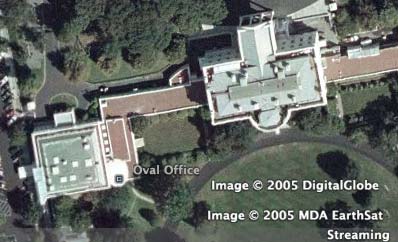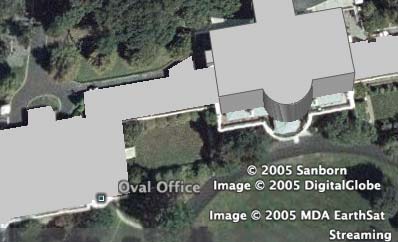Much as I hate to play the radical moderate in this latest below-the-beltway she-said she-said blog fracas regarding the blurriness of the Den of Vice (President Cheney), the facts are: The New York Times corrections page is correct:
Although images of the White House and its environs are now clear in the Google Earth database, the view of the vice president’s residence in Washington remains obscured.
Check for yourself [KML]. He lives next to the Naval Observatory, on the north-eastern slice of the blurred circle. It’s easy enough to cycle by it and ogle the house through the fence (or at least it was in 1994-95, when I lived a few blocks away, and there was always an off-chance of catching a glimpse of the then very eligible Gore daughters. Not that I was stalking or anything:-)
The Veep’s residence is the only blurred bit that I’ve encountered of late in Google Earth. There are likely more concealed bits on US military bases, but in the past, clamour enough and Google refreshes the database with clear views at the next update — case in point is Area 51. One likely explanation is that these images are blurred by vendors and US authorities by default, to err on the side of caution, but that the blurring is removed on request, because USGS guidelines state that public availability anywhere of high resolution aerial imagery of a place is sufficient cause for everyone being allowed to provide such high-resolution images to the public.
So where does that leave us? I have one comment on Maureen Dowd’s piece, and one remaining correction for the New York Times article.
Re Dowd: She ascribes the blurriness of Cheney’s residence to a wider penchant by Cheney for secrecy. That’s a conspiracy theory which does not have much going for it by way of actual evidence. I’d be much more impressed if there were some kind of assertion bolstered by evidence that Cheney himself decreed that US satellite operators may not unblur his residence, even while the White House was given the green light for a full-resolution view. More likely is that nobody requested that Observatory Circle be unblurred last time there was a brouhaha regarding the obfuscated White House (upon which the next update saw the White House imagery upgraded). It was likely just an oversight, then — literally (ha!).
Re the New York Times article: While the correction itself is correct, I am still very suspicious about the second sentence in this paragraph of the article:
For a brief period, photos of the White House and adjacent buildings that the United States Geological Survey provided to Google Earth showed up with certain details obscured, because the government had decided that showing details like rooftop helicopter landing pads was a security risk. Google has since replaced those images with unaltered photographs of the area taken by Sanborn, a mapping and imagery company, further illustrating the difficulty of trying to control such information.
The problem is that I don’t think it is Sanborn which provides the current imagery of the White House. I think Sanborn just provides the 3D building models for Washington DC (which it indeed does sell). Why do I think this? Because without buildings turned on, Sanborn’s credits do not appear, though the White House is there in all its full-resolution glory.

With buildings turned on, Sanborn’s credits appear.

Unless this is an error in Google Earth’s crediting, I think it is MDA Earthsat and Digital Globe that continue to provide the imagery of the area, but that they have now received clearance to sell full-resolution images. One other reason why Sanborn is not the likely source for the resolution upgrade of the White House is that it, too, is an American “private remote sensing operator” (albeit an aerial one), so Google merely switching vendors from one US company to another US company would not be sufficient to overcome US government restrictions, should those have continued to be in force. More likely, Google argued successfully that the rooftops of the White House (and Congress) are not plausibly a state secret any more, and that hence they should be visible, as per the guidelines.


